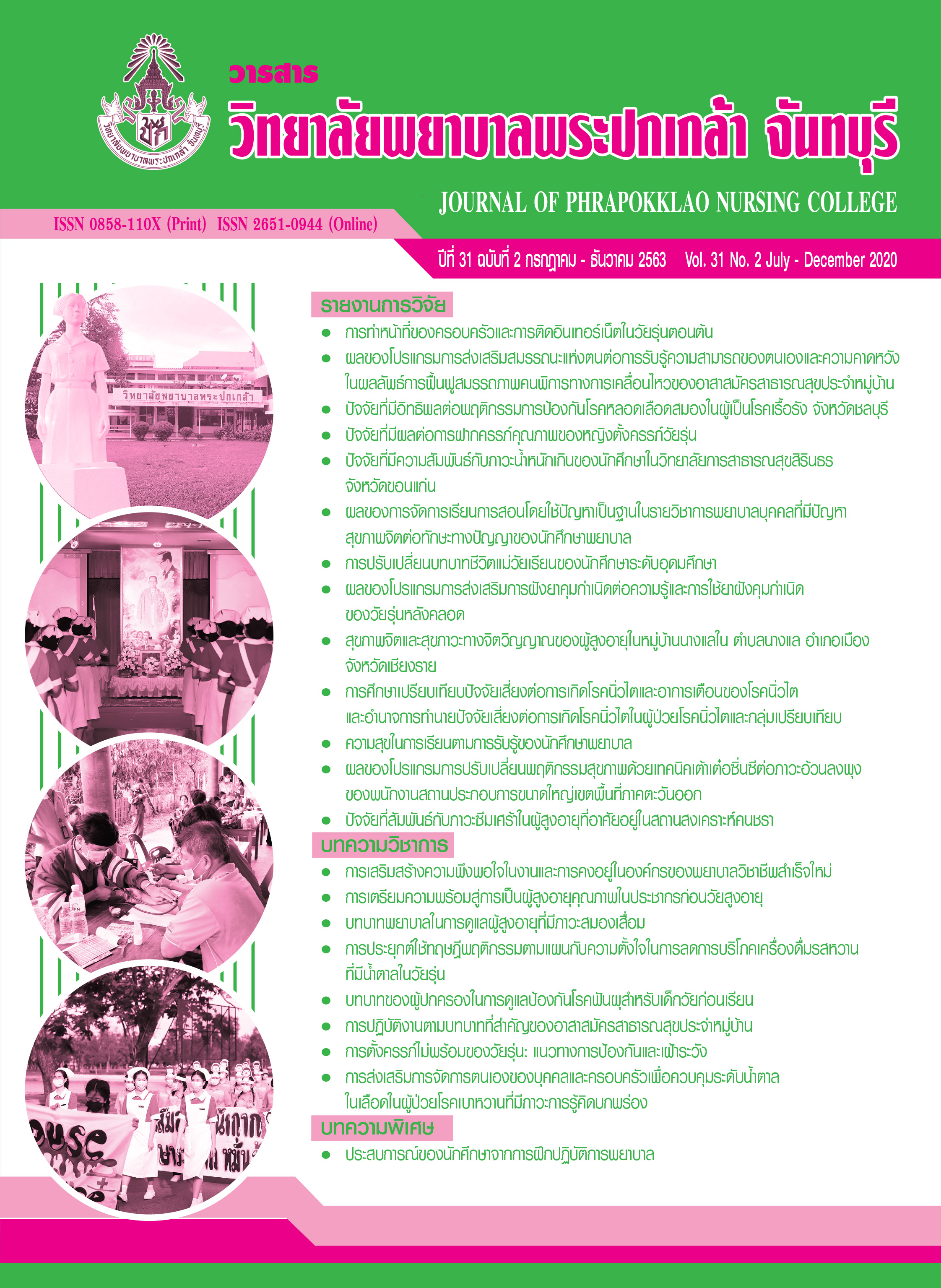Mental Health and Spirituality among Older Adults in Nang Lae Nai Village, Nang Lae Subdistrict, Muang District, Chiang Rai Province
Keywords:
Mental health, Spirituality, Older adultAbstract
This explanatory sequential mixed methods design aimed to examine the relationship between mental health and spirituality, and to determine the mental health and the spirituality as perceived by older adults. The samples consisted of 102 older adults who lived in Nang Lae Nai Village, Nang Lae Subdistrict, Muang District, Chiang Rai Province and were arranged for quantitative research (n = 102) and qualitative research (n = 10). The research instruments consisted of the personal data record form, Thai Mental Health Indicator Version 2007 (TMHI-15) with the reliability of .86, the spirituality questionnaire with the reliability of .86, and the focus group interview guide. Data were collected from January to April, 2019. Statistics used for data analysis included frequency, percentage, mean, standard deviation, Spearman rank correlation, and content analysis.
The research results revealed that mental health was positively statistically significant related to spirituality among older adults (rs = .606, p < .001). The mental health as perceived by older adults consisted of 4 issues, including 1) anxiety regarding disease and self-care, 2) emotional coping, 3) being proud in life, and 4) received care and acceptance from family and community. In addition, the spirituality as perceived by older adults consisted of 3 issues, including 1) moral and virtue fulfilling, 2) self-esteem, and 3) happiness and satisfaction.
This research suggests that people related to elderly health promotion should apply this research results for promoting mental health of older adults according to the contexts (e.g., providing precedence, awareness in older adults’ esteem, and participation) in order to enhance the mental health and spirituality among older adults.
References
กรมกิจการผู้สูงอายุ. (2562). สถิติผู้สูงอายุของประเทศไทย 77 ณ วันที่ 31 ธันวาคม 2562. สืบค้นจาก http://www.dop.go.th/download/knowledge/th1580099938-275_1.pdf
กรมสุขภาพจิต. (2550). แบบทดสอบดัชนีชี้วัดสุขภาพจิตคนไทยฉบับสั้น 15 ข้อ [Thai Mental Health Indicator Version 2007 = TMHI-15]. สืบค้นจาก https://www.dmh.go.th/test/thaihapnew/thi15/asheet.asp?qid=1
กองสาธารณสุขและสิ่งแวดล้อม เทศบาลตำบลนางแล อำเภอเมือง จังหวัดเชียงราย. (2561). รายงานประจำปี 2561. เชียงราย: ผู้แต่ง.
กุลวดี โรจน์ไพศาลกิจ. (2559). ความสัมพันธ์ของกิจกรรมทางกายกับสุขภาวะทางจิต สังคม และจิตวิญญาณของผู้สูงอายุสามวัย. วารสารศูนย์การศึกษาแพทยศาสตร์คลินิก โรงพยาบาลพระปกเกล้า, 33(4), 300–313.
เกสร มุ้ยจีน. (2558). ปัจจัยที่มีผลต่อระดับสุขภาพจิตของผู้สูงอายุ. วารสารวิทยาศาสตร์และเทคโนโลยี มหาวิทยาลัยธรรมศาสตร์, 23(2), 306–318.
ฉัตรฤดี ภาระญาติ, วารี กังใจ, และสิริลักษณ์ โสมานุสรณ์. (2559). ปัจจัยทำนายพลังสุขภาพจิตของผู้สูงอายุ. วารสารคณะพยาบาลศาสตร์ มหาวิทยาลัยบูรพา, 24(2), 97–106.
พรทิพย์ สารีโส, ปิยะภร ไพรสนธิ์, อุษาษ์ โถหินัง, วรางคณา อ่ำศรีเวียง, และนารีลักษณ์ ฟองรัตน์. (2560). สถานการณ์ ปัญหาสุขภาพและความต้องการการดูแลของผู้สูงอายุโรคเรื้อรัง: เขตเทศบาลเมืองเชียงราย. วารสารพยาบาลศาสตร์และสุขภาพ, 40(2), 85–95.
มูลนิธิสถาบันวิจัยและพัฒนาผู้สูงอายุไทย. (2559). สถานการณ์ผู้สูงอายุไทย พ.ศ. 2559. กรุงเทพฯ: โรงพิมพ์พริ้นเทอรี่.
มูลนิธิสถาบันวิจัยและพัฒนาผู้สูงอายุไทย. (2561). สถานการณ์ผู้สูงอายุไทย พ.ศ. 2560. กรุงเทพฯ: โรงพิมพ์เดือนตุลา.
มูลนิธิสถาบันวิจัยและพัฒนาผู้สูงอายุไทย. (2562). สถานการณ์ผู้สูงอายไทย พ.ศ. 2561. กรุงเทพฯ: โรงพิมพ์พริ้นเทอรี่.
เมธี วงศ์วีระพันธุ์. (2559). การส่งเสริมสุขภาพจิตสำหรับผู้สูงอายุของชุมชนต้นแบบในจังหวัดเชียงใหม่. วารสารจิตวิทยาคลินิก, 47(1), 38–47.
รุ่งทิพย์ รัตนไมตรีเกียรติ, และนัยนา พิพัฒน์วณิชชา. (2560). ปัจจัยที่เกี่ยวข้องกับความต้องการด้านจิตวิญญาณของผู้สูงอายุที่ได้รับการผ่าตัดแบบนัดล่วงหน้า. วารสารพยาบาลสงขลานครินทร์, 37(2), 14–26.
ศักดิ์ชาย เพ็ชรตรา, มรรยาท เพ็ชรตรา, และทัศพร ชูศักดิ์. (2562). ภาวะสุขภาพจิตของผู้สูงอายุจังหวัดชัยภูมิ กรณีศึกษา: ตำบลนาฝาย อำเภอเมือง จังหวัดชัยภูมิ. วารสารวิจัยและพัฒนา วไลยอลงกรณ์ ในพระบรมราชูปถัมภ์ สาขาวิทยาศาสตร์และเทคโนโลยี, 14(2), 88–101.
สถาบันวิจัยประชากรและสังคม มหาวิทยาลัยมหิดล. (2562). สุขภาพคนไทย 2562. กรุงเทพฯ: โรงพิมพ์อมรินทร์พริ้นติ้งแอนด์พับลิชชิ่ง.
สำนักงานสถิติแห่งชาติ. (2558). การสำรวจสุขภาพจิต (ความสุข) ของคนไทย พ.ศ. 2558. สืบค้นจาก http://service.nso.go.th/nso/nsopublish/themes/files/mental-healthm_aug_58.pdf
สํานักงานสถิติแห่งชาติ. (2563). การสํารวจอนามัยและสวัสดิการ พ.ศ. 2562. กรุงเทพฯ: โรงพิมพ์ธนาเพรส.
สำนักงานสภาพัฒนาการเศรษฐกิจและสังคมแห่งชาติ. (2562). รายงานการศึกษาผลกระทบจากการเปลี่ยนแปลงโครงสร้างประชากร และข้อเสนอแนะเชิงนโยบายต่อการพัฒนาประเทศ จากผลการคาดประมาณประชากรของประเทศไทย. กรุงเทพฯ: โรงพิมพ์อมรินทร์พริ้นติ้งแอนด์พับลิชชิ่ง.
แสงเดือน พรมแก้วงาม, และอรัญญา นามวงศ์. (2560). ความผาสุกทางจิตวิญญาณของผู้สูงอายุโรคเรื้อรังในชุมชน. วารสารการพยาบาลและการดูแลสุขภาพ, 35(3), 204–213.
อภิรดี โชนิรัตน์, วิราพรรณ วิโรจน์รัตน์, คนึงนิจ พงศ์ถาวรกมล, และศริยามน ติรพัฒน์. (2563). ปัจจัยทํานายการสูงวัยอย่างมีสุขภาวะของผู้สูงอายุ. วารสารพยาบาลโรคหัวใจและทรวงอก, 31(1), 93–108.
อารี พุ่มประไวทย์, บรรจง เจนจัดการ, ปาหนัน กนกวงศ์นุวัฒน์, อัญชลี เหมะญาติ, และณัฐฐพัชร์ จันทร์ฉาย. (2562). ผลของโปรแกรมการสร้างเสริมความมีคุณค่าในตนเองต่อภาวะซึมเศร้าของผู้สูงอายุตำบลบ่อพลอย อำเภอสามโคก จังหวัดปทุมธานี. วารสารคณะพยาบาลศาสตร์ มหาวิทยาลัยบูรพา, 27(1), 33–41.
Bruce, A., Schreiber, R., Petrovskaya, O., & Boston, P. (2011). Longing for ground in a ground (less) world: A qualitative inquiry of existential suffering. BMC Nursing, 10(1), 1–9.
Daaleman, T. P., Usher, B. M., Williams, S. W., Rawlings, J., & Hanson, L. C. (2008). An exploratory study of spiritual care at the end of life. Annals of Family Medicine, 6(5), 406–411.
Lavretsky, H. (2010). Spirituality and aging. Aging Health, 6(6), 749–769.
McCoubrie, R. C., & Davies, A. N. (2006). Is there a correlation between spirituality and anxiety and depression in patients with advanced cancer?. Support Care Cancer, 14(4), 379–385. Retrieved from https://doi.org/10.1007/s00520-005-0892-6
Paloutzian, R. F., & Ellison, C. W. (1982). Loneliness, spiritual well-being and the quality of life. In L. A. Peplau & D. Perlman (Eds.), Loneliness: A sourcebook of current theory, research and therapy (pp. 224–237). New York: Wiley.
Uusi-Rasi, K., Karinkanta, S., Tokola, K., Kannus, P., & Sievanen, H. (2019). Bone mass and strength and fall-related fractures in older age. Journal of Osteoporosis, 2019, 1–6. doi:10.1155/2019/5134690
World Health Organization. (2014). Noncommunicable disease country profiles, 2014. Geneva: WHO Document Production Services.
Downloads
Published
How to Cite
Issue
Section
License
Copyright (c) 2020 JOURNAL OF PHRAPOKKLAO NURSING COLLEGE

This work is licensed under a Creative Commons Attribution-NonCommercial-NoDerivatives 4.0 International License.
เนื้อความ ข้อมูล และรายการอ้างอิงที่ผู้เขียนใช้ในการเขียนบทความเพื่อลงตีพิมพ์ในวารสารวิทยาลัยพยาบาลพระปกเกล้า จันทบุรี ถือเป็นความคิดเห็นและความรับผิดชอบของผู้เขียน คณะผู้จัดทำวารสารไม่จำเป็นต้องเห็นพ้องด้วยหรือร่วมรับผิดชอบ
บทความที่ได้รับการลงตีพิมพ์ในวารสารวิทยาลัยพยาบาลพระปกเกล้า จันทบุรี ถือเป็นลิขสิทธิ์ของวารสารวิทยาลัยพยาบาลพระปกเกล้า จันทบุรี หากหน่วยงานหรือบุคคลใดต้องการนำส่วนหนึ่งหรือทั้งหมดของบทความไปเผยแพร่ต่อเพื่อวัตถุประสงค์ใด ๆ จะต้องได้รับอนุญาตจากบรรณาธิการวารสารก่อน



